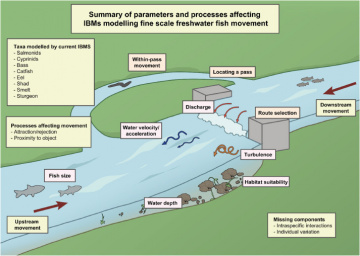Paper: Individual based models for the simulation of fish movement near barriers
RIBES Early Stage Researcher Rachel Mawer together with RIBES Supervisors Mattias Schneider and Peter Goethals, fellow ESR Jelger Elings, and others, recently published the review paper “Individual based models for the simulation of fish movement near barriers: Current work and future directions” in Journal of Environmental Management.

In the abstract they write: "River fragmentation is an increasing issue for water managers and conservationists. Barriers such as dams interfere with freshwater fish migration, leading to drastic population declines. While there are a range of widely implemented mitigation approaches, e.g. fish passes, such measures are often inefficient due to suboptimal operation and design. There is increasing need to be able to assess mitigation options prior to implementation. Individual based models (IBMs) are a promising option. IBMs can simulate the fine-scale movement of individual fish within a population as they attempt to find a fish pass, incorporating movement processes themselves. Moreover, IBMs have high transferability to other sites or conditions (e.g. changing mitigation, change in flow conditions), making them potentially valuable for freshwater fish conservation yet their application to the fine-scale movement of fish past barriers is still novel. Here, we present an overview of existing IBMs for fine-scale freshwater fish movement, with emphasis on study species and the parameters driving movement in the models. In this review, we focus on IBMs suitable for the simulation of fish tracks as they approach or pass a single barrier.
The selected IBMs for modelling fine-scale freshwater fish movement largely focus on salmonids and cyprinid species. IBMs have many applications in the context of fish passage, such as testing different mitigation options or understanding processes behind movement. Existing IBMs include movement processes such as attraction and rejection behaviours, as reported in literature. Yet some factors affecting fish movement e.g. biotic interactions are not covered by existing IBMs. As the technology available for fine scale data collection continues to advance, such as increasing data linking fish behaviour to hydraulics, IBMs could become a more common tool in the design and implementation of fish bypass structures."rachel ![]() (53.94 kB)
(53.94 kB)
